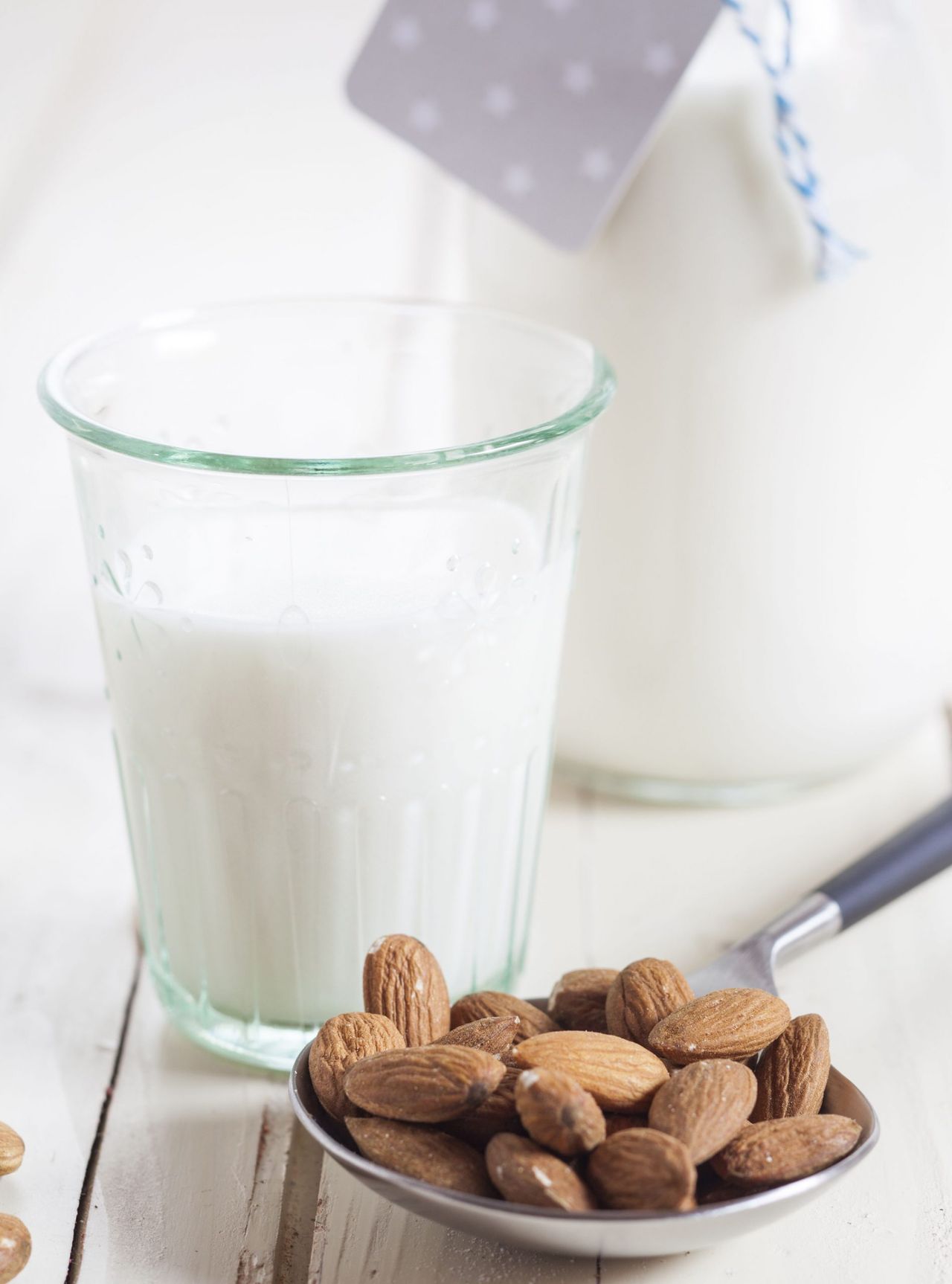The Duchess' Almond Milk Diet Trick Revealed

Semi-skimmed pasteurised cow's milk is still the UK's favourite, but the popularity of dairy alternatives, including soya, almond and coconut milk, have shot up in the past five years, with around 42 million litres sold in the UK every year. And, sales of almond milk have surpassed soya milk as the go-to dairy alternative for the first time.
The Duchess of Cambridge is reportedly a fan of almond milk and uses it to help conquer her sugar cravings. The International Business Times revealed that Catherine opts for a healthy blend of berries and almond milk, or occasionally she'll indulge in dark chocolate and gummy candies.
But how does it compare to cow's milk and the other alternatives?
Almond milk is known for being low calorie, full of vitamin E and having more protein than other plant milks, so there's little wonder why it's the Duchess' drink of choice.
These milks promise to be 'easier to digest' than cow's milk, 'naturally lower in fat' and full of essential vitamins, but do the health claims stand up to scrutiny?
And what about cow's milk? The once popular beverage has been demonised in recent years, with cases of lactose intolerance and allergies increasing and experts reporting high levels of growth hormone present in milk.
Full fat, skim, soy, almond...which is healthiest? We sort the fact from the fiction and give you the lowdown on what milk products are best for you.
Sign up for the woman&home newsletter
Sign up to our free daily email for the latest royal and entertainment news, interesting opinion, expert advice on styling and beauty trends, and no-nonsense guides to the health and wellness questions you want answered.
Full fat vs. low fat milk
Despite the popularity of low-fat milk (semi-skimmed or skimmed), research suggests that full-fat milk is better for you. Studies have shown that people who consume whole milk and whole milk products weight less and are less likely to develop diabetes.
In a new study published in the journal Circulation, Dr. Dariush Mozaffarian and his team analysed the blood of 3,333 adults taking part in the 15-year study. Results showed that people who consumed more full-fat dairy had, on average, a 46% lower risk of getting diabetes that those who ate less.
"I think these findings together with those from other studies do call for a change in the policy of recommending only low-fat dairy products," said Dr. Mozaffarian. "There is no prospective human evidence that people who eat low-fat dairy do better than people who eat whole-fat dairy."
When people reduce the fat in their diet, they're likely to replace it with sugar and carbohydrates which can increase the risk of developing diabetes. It is thought that dairy fats may be acting directly on cells, improving their ability to break down sugars in food. Whole milk contains fewer carbohydrates than skimmed milk litre-for-litre, however it also contains less protein.
Do I have a milk allergy?
Milk proteins, fats or sugars can all cause intolerance. However, the most common culprit is the milk sugar, lactose. Symptoms include diarrhoea, bloating and abdominal discomfort.
The most reliable way to diagnose an intolerance is 'exclusion and challenge' - you exclude milk and dairy products to see if symptoms disappear and reintroduce them to see if they return. If you suspect you are affected, ask your GP to refer you to a state registered dietician.
Some affected individuals can tolerate a small amount of milk - say in tea - but not larger amounts. Cow's milk, sheep's milk, goat's milk and buffalo milk all contain a similar amount of lactose.
Cow's milk intolerance is not to be confused with a cow's milk allergy, which is a reaction of the immune system against cow's milk proteins. It can cause a host of symptoms including diarrhoea, nausea, vomiting, breathing problems and rashes.
Which 'milk' is best for you if you can't stomach cow's milk?
Choose your 'milk' according to what you want to use it for - they all have different flavours, so it's a good idea to try a few to see what you prefer. Like more than one? Mixing and matching dairy and non-dairy ensures you get as many varied nutrients as possible.
Almond milk
Why use it? For weight-loss - it has more protein than grain-based milks such as rice (although less than cow's milk), so helps keep you satisfied for longer.
Why not? May contain added sugar or agave syrup, which some people find causes wind, as well as salt and food additives. Unsuitable for those with a nut allergy.
Taste? Sweetish and almondy - good over cereal and in pancakes, mashes and cakes but can curdle in tea and coffee.
Try? Making your own with food blogger, Tory's DIY almond milk recipe or Blue Diamond Almond Breeze, £1.49
Goat's milk
Why use it? More digestable than cow's milk due to smaller, more easily digested fat molecules, as well as lower levels of alpha s1-casein, thought to be responsible for cow's milk allergy. Contains less lactose than cow's milk. If you have problems with cow's milk, you may experience fewer IBS-type symptoms, less catarrh and less asthma and excema. Prebiotic sugars make for a healthier gut. A 200ml glasses provides 29% of adult calcium needs.
Why not? Lower levels of B vitamins and zinc than cow's milk. Some proteins similar to cow's milk and can cause problems in people with a cow's milk allergy, so don't switch without advice for a qualified expert.
Taste? Like a slightly 'stronger' cow's milk. Can be an acquired taste.
Try? St Helen's Farm Fresh Skimmed Goat's Milk, £1.60
Oat milk
Why use it? For cholestorol-lowering beta glucans, a soluble fibre and heart-healthy mono- and polyunsaturated fats. If fortified with calcium, contains more calcium per glass than cow's milk. It also contains slightly more protein than almond milk.
Why not? Higher in carbohydrate than soya milk, so maybe less good for weight loss. Some varieties contain sugar and other additives.
Taste? Mild and sweetish with a hint of oats. Good in tea and coffee, and over cereals.
Try? Oatly Healthy Oat Drink, £1.39
Rice milk
Why use it? Less likelyto cause allergies than cow's milk or soya. Naturally sweet taste may be preferable to soya. Go for calcium-enriched varieties.
Why not? More watery and thinner than soya milk. Also high in carbs and may have added sugar.
Taste? Slightly sweet. Good on cereal but you may find it too sweet and watery in tea and coffee.
Try? Rice Dream with Calcium, £1.38
Hazelnut milk
Why use it? For heart-healthy monosaturated fats and calcium, plus vitamins B2, B12, D and E.
Why not? Low in calcium unless it has been added - check the pack. May contain agave syrup. Unsuitable for those with a nut allergy.
Taste? Light, creamy and sweetish with a tinge of hazelnut. Good in smoothies and shakes, and over cereal.
Try? Ecomil Hazelnut Drink, £4.75
Soya milk
Why use it? To help lower cholesterol and menopausal symptoms - women in countries who drink soya have fewer hot flushes and a lower risk of breast cancer. Most similarly nutritionally to cow's milk.
Why not? Non-organic varieties may be gentically modified. May be sweetened with sugar and high in salt. Unsuitable if you're one of the 5% of people allergic to soya.
Taste? Slightly creamy and nutty - you tend to either love it or loathe it.
Try? Alpro Organic, £1.39
Coconut milk
Why use it? For medium chain fatty acids (MCFAs), types of saturated fatty acids, which are easier to digest and have a better health profile than other saturated fatty acids. This type of coconut milk is not the same as the canned varieties used to make curries.
Why not? May be sweetened with sugar and have added salt and other additives.
Taste? Similar to skimmed milk with the slightest hint of coconut.
Try? Kara Dairy-Free Coconut Milk, £1.69
-
 The diet linked to longer and better sleep, revealed by new study
The diet linked to longer and better sleep, revealed by new studyThe study looked at data from tracking apps to see what foods were more likely to lead to better sleep
By Kat Storr Published
-
 Prince George’s hilarious warning for TV star passed on by Prince William ahead of series cameo
Prince George’s hilarious warning for TV star passed on by Prince William ahead of series cameoThe Prince of Wales has passed on a cheeky message from Prince George to the star of one of his new favourite shows
By Emma Shacklock Published